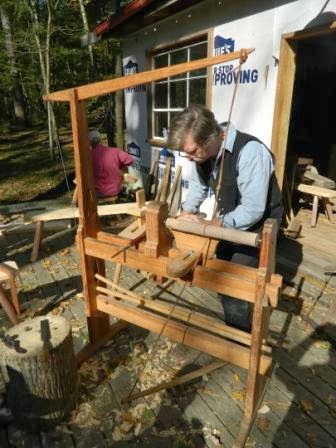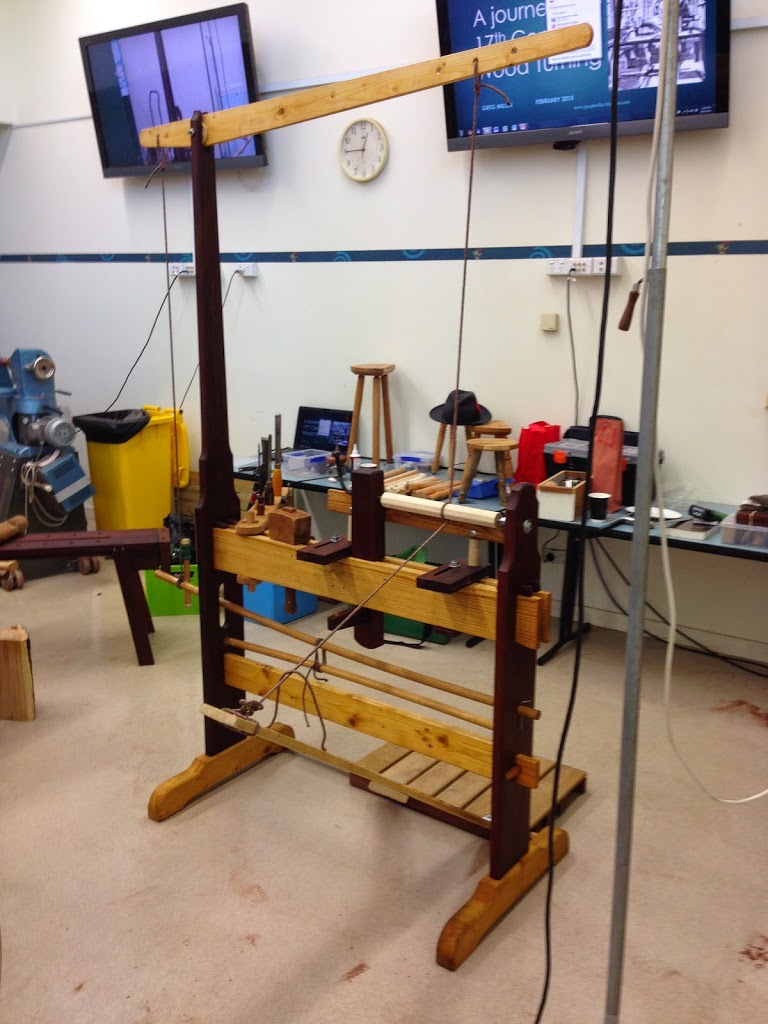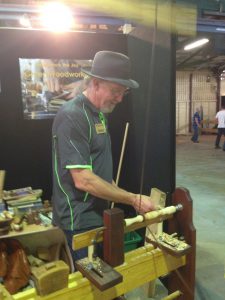Love that Double Spring Pole Lathe!
It all started when I did the Woodcraft Week with Roy Underhill in North Carolina in November 2013. I saw and tried Roy’s Double Spring Pole Lathe.
 |
| Roy Underhill at work on his Spring Pole Lathe. |
Roy’s lathe knocks down and all fits into a golf bag! It was the first time I had seen a pole lathe in action, and I knew I would have to make one when I returned to Australia. Of course I had seen many pics of the English style with the massive long poles, but this version, which Roy says he found in a 17th Century German Technical manual, is more compact. Nice one…
So I made two of the Roy-type double spring pole lathes at the same time – all made from recycled timber. I made them in time for a green woodworking workshop I was running in September 2014. Sometimes a deadline helps to ensure things get done! Over a period of about 3 weeks, doing a little bit each day, I managed had complete the two lathes – just in time for the workshop.
 |
| Doing a demo on the new lathes, Sept 2014. With Foot Pedal Version I, like Roy’s. |
Making the Lathes.
I had found a copy of the plan for Roy’s Spring Pole Lathe on the internet. ((Months later I would find the plans in his book: “The Woodwrights Guide – Working Wood with Wedge and Edge”, (2008)
So I set about finding the material for the components. As I am very committed to wood recycling, I used a combination of pre-used material as follows:
- Yellow Pine from the USA, ex. packing crates, for the beds, tool rests, and lower spreaders.
- Some unknown Northern Hemispherical pine-type softwood ex. packing crates from the UK, for the top lever arms, and the foot pedals.
- Some unknown Northern Hemispherical pine-type softwood ex.packing crates from Belgium, for the feet.
- Jarrah ex. building salvage for the uprights, bed wedges, poppets (tail stocks), and tool rest platforms.
In addition the following new timber was used:
- Tassie Oak 1″ dowelling for the spring poles, the tool rest posts, and for the round peg wedges on the ends of the lower stretchers.
The Hardware used:
- Too much ZP steel in the 3/8″ nuts, bolts and washers … Oh for a friendly blacksmith!
- Old square headed bolts from an ancient bed frame, for the tailstock centres.
- Woven nylon cord, for the drive cord etc.
- Galvanised 4″ nails, bent, as pegs for the spring poles.
I’m taller than Roy, so I made my lathes about 8″ taller. The lever arms are a little longer too. The tool rest is a bit more like that off a powered lathe, too. it works very nicely.
 |
| Dovetailed joint of bed to uprights, pulled up with jarrah wedges. |
There are several ways jointing the uprights to the bed. I opted to do a dovetailed variation, where the top of the bed is flat, and the wedges driven in along this help to pull up the bottom dovetail while completing the top dovetail. Great for a knock-down construction.
 |
| Round tapered pegs pull up the joints for the lower stretcher. |
 |
| The main spring pole is held in the static end with a bent 4″ nail pin each side of the upright. |
 |
| Starting with a hexagonal/roughed round blank. Foot Pedal Version II – with hinged board. |
 |
| The finished product… a low stool’s leg. Tenon left slightly oversize until required for use. The nylon drive cord has gotta go! Looking for a leather one… |
 |
| Foot pedal Version II – attached to a hinged board. |
I have used the lathes at several workshops, and many people at my home had had a go. When using the lathe for the first time, the single board type treadle is very tricky for people to use while simultaneously getting the foot action going smoothly as well as the tool subtlely moving in and out. There’s lots going on, and in a workshop environment, there isn’t a lot of time for people to put it all together. Hence Version II, which made it a bit easier for beginners, and then Version III foot pedal which has made a huge difference.
 |
| Ready for a demo at the West Australian Woodturners Association, with the current Foot Pedal Version III – hinged on a sliding platform. |
Version III Foot Pedal, though big, works like a dream with beginners. The platform, to which the Y-shaped foot pedal is hinged, slides along a big dowel which is housed into each of the lathe’s feet. This removes any tilting action out of the lathe body, caused by the lateral pull of the longer foot pedal. The longer pedal gives a bigger rotating action. Beautiful. By sliding the platform along its dowel, you can shift the position of the drive cord on the workpiece.
 |
| A nice drive cord! Leather skipping rope. |
At my local flea market a couple of months ago, I was stoked to find a leather skipping rope for sale for $3. Fantastic! At last I have a leather drive cord! After removing the handles, the length proved to be just perfect. Awesome! Now I need to find 3 more of these, to remove all nylon cord from the 2 lathes…
I was demonstrating Green Woodworking skills for Timbecon recently at the Brisbane Timber and Working with Wood Show. Along with a shaving horse, chopping block and heaps of tools and wood, I had my Double Spring Pole Lathe there. Doing demos on this was always a crowd magnet. People were fascinated by the action of my 18th Century lathe, which would have been cutting edge German engineering in its day!
 |
| Doing a demonstration in Brisbane. |
It was fun doing demos, and of course I like to invite punters from the crowd to come and have a go. This includes people from the Turning fraternity who were at the Show.
Here is a short clip of the one of the volunteers having a go:
My lathe is a joy to use… and a work in progress as I seek to make it more authentic. The leather drive cord was a step in the right direction.
 |
| Two nice sets of Cape Lilac stool legs, turned on the lathe. Sometimes I just use it to turn tenons on shaved legs. |
Sometime soon I hope to make a kids sized double spring pole lathe. Yep. Kids sized.
Meanwhile, I love my lathe, and look forward to doing demos with it at the Sydney Timber & Working with Wood Show, in a few weeks time.
Roy, thanks for inspiring me (and so many other people) with this beautiful compact lathe.

Hi Greg
I built the spring pole lathe at a Roy class in November 2016. I like your version 3 treadle…can you post a picture of the front of it? The picture from the back obscures how it goes together. Thanks!
Sydney Smith
Yes; please post detailed photos of your version III treadle.
Thanks!
Hello Greg I'd be interested in any info on your latest version of lll treadle lathe. Cheers John